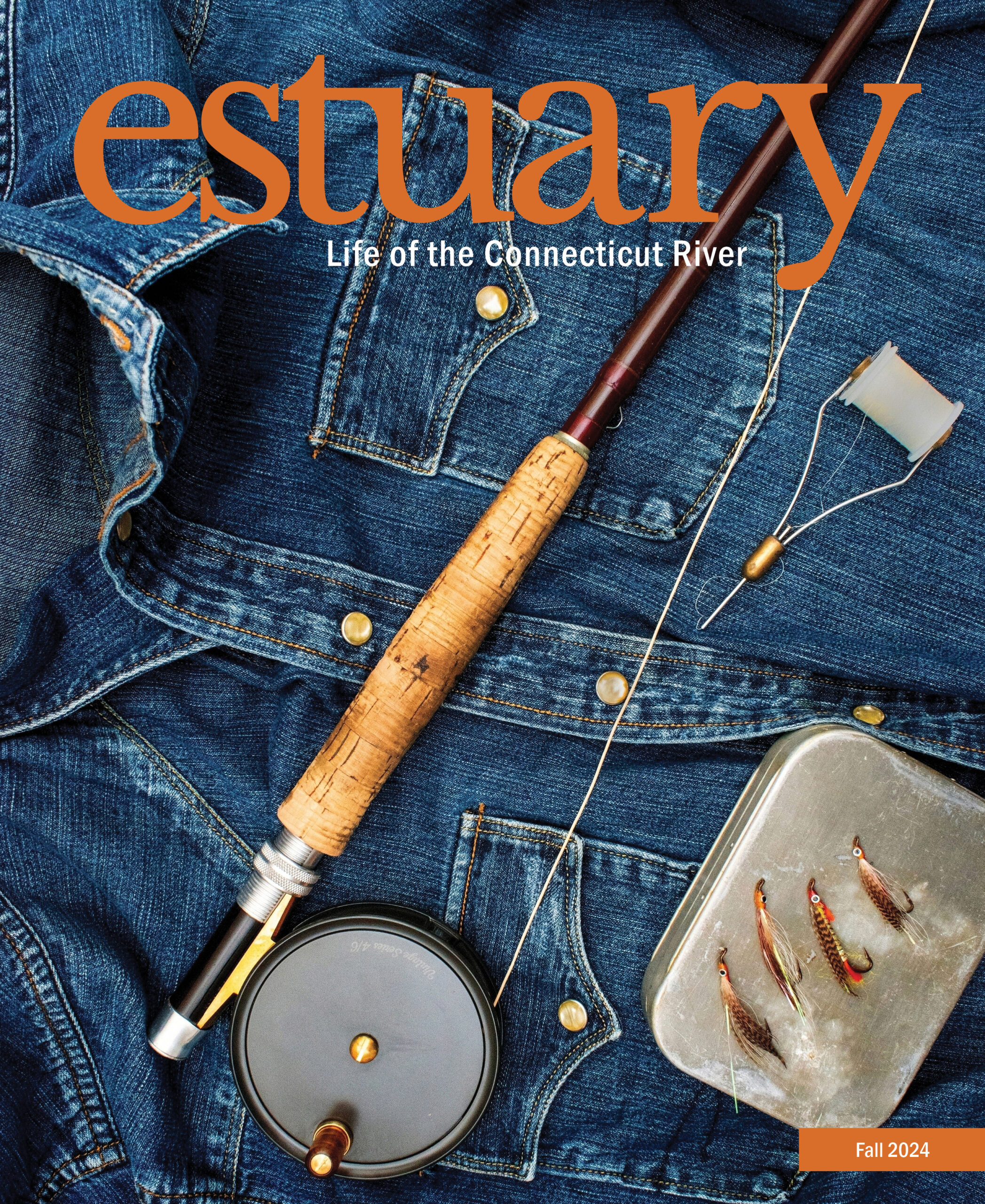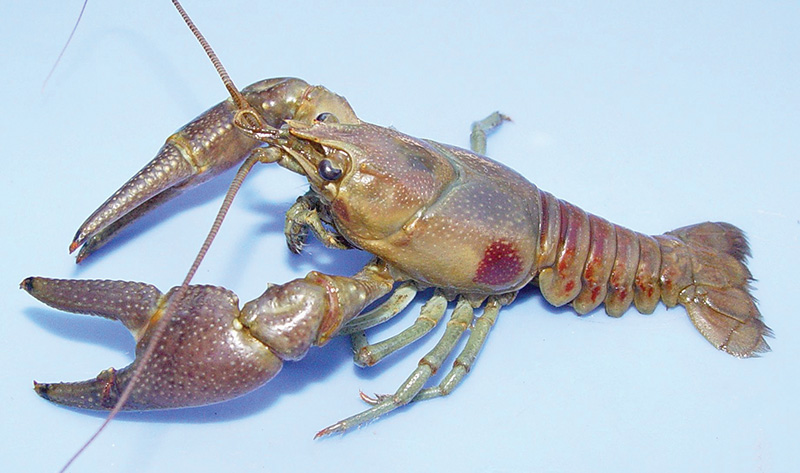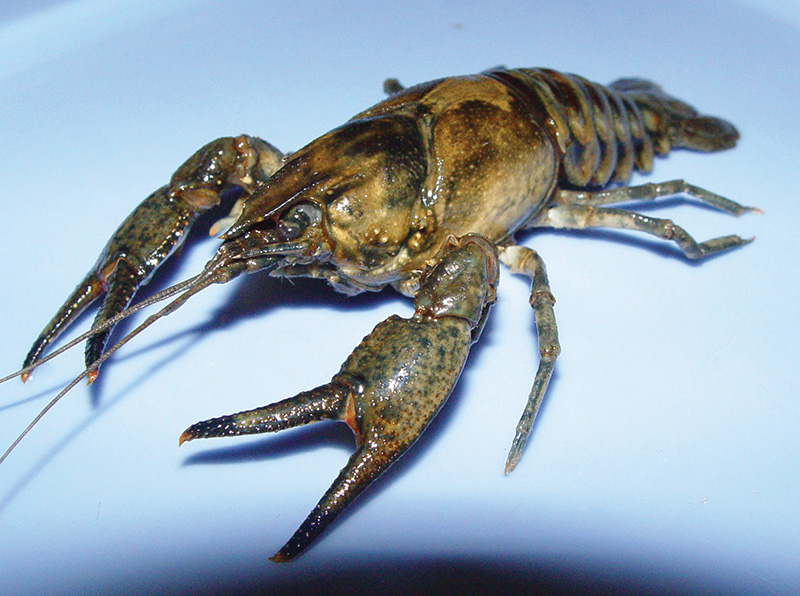 This article appears in the Fall 2024 issue
This article appears in the Fall 2024 issue

Know Your Crayfish
By Andrew Fisk

Rusty crayfish (Orconectes rusticus) is native to the southern US and considered invasive in the Connecticut River watershed where it was likely introduced by anglers. Images Credit: R. Jacobs, courtesy of Bureau of Natural Resources/Fisheries Division, Connecticut Department of Energy & Environmental Protection.
Crayfish, crawdad, mud bug—what’s your preference?
I’ve lived around the country, growing up in Georgia, Maryland, South Carolina, and New Jersey. As an adult I landed in the Midwest for a few years, then to Maine, and now western Massachusetts. I’ve heard many variations on what carbonated beverages (soda, pop) and sandwiches (hoagies, subs, grinders) are called, and I’ve had my tea both sweetened and not.
But those miniature lobsters that I found as a kid hiding under rocks in creeks and streams? They were always crayfish in my lingo. I guess despite my Southern roots, I never stayed long enough in one place as a child to cabbage on to “crawdad” or “mud bug.” In a nod to my Australian friends, I could call them the really fetching name of “yabbies.” (Australia, like many other unusual things about its wildlife, is home to the largest crayfish, which can weigh in at several pounds!)
Yes, crayfish are crustaceans that are in the same taxonomic order as the better-known lobster, and they share the same segmented body type, foraging strategies, and habits of reproduction. They just come in a small size package, and for most of the species, they live in freshwater systems including throughout the Connecticut River watershed.
Crayfish are correctly deemed a fish as they live entirely underwater and have gills. They are part of a healthy, functioning aquatic environment where they live and forage in streams, lakes, and wetlands. They occupy the benthic (or bottom) niche in these environments and are omnivorous, being willing to eat most anything from insects to vegetation or even to filter bottom sediments for small particles of food. While at their scale their claws may seem to make them ferocious hunters, they rely on plants and detritus, only catching an occasional insect or small fish.
Most crayfish are homebodies with a limited range. They appear cautious in their habits by spending most of their daylight hours hidden under rocks. Nighttime is their preferred time to forage and scavenge. It may appear a sort of hard-luck existence scrambling about in the mud and detritus, but critters with this life history perform an important role of processing the plant or other decaying materials that would otherwise accumulate and overwhelm the environment.
Here in the Connecticut River watershed, there are only a few native species of crayfish. The rest of the documented species (between four and five) have been introduced, including—as is a distressingly common occurrence—one invasive species. While not avid hunters themselves, they are an appealing prey species for many fish, making them very popular with anglers as bait. Anglers are the culprits for the spread of crayfish outside their home waters.
While a small creature, the rusty crayfish (Faxonius rusticus) can have outsize impacts. It has been tagged as invasive due to its aggressive behavior and, as a result of its voracious appetite, its ability to outcompete other species including vegetation. Its ability to clear vegetation from areas of rivers and streams eliminates habitat for insects and nursery habitat for young fish species and can accelerate erosion. Disrupting the bottom of the food chain has direct impacts up the food chain, so these little guys can be big trouble.

Spiny-cheek crayfish (Orconectes limosus) is native to the East Coast from Quebec to Virginia.
Knowing one crayfish from another might seem a challenge, and the various species are often definitively identified by close inspection of a pair of their modified swimming appendages on a male called gonopods. There are a few clearer differences among the species you will find in our part of the world. To sort out the most unwelcome visitor, you can tell a rusty crayfish by a small red patch along its shell near its tail. Other species have very large or long pincers relative to their body size. But definitive species identification does require some expertise.
Crayfish are a popular bait for anglers and are allowed according to each state’s fishing regulations, though the four states in the watershed prohibit the use of rusty crayfish. The best practice is to use crayfish from the waterbody in which you are fishing to further limit the spread of introduced species.
Andrew Fisk, PhD, is the Northeast Regional Director for American Rivers. American Rivers is championing a national effort to protect and restore all rivers, from remote mountain streams to urban waterways. Healthy rivers provide people and nature with clean, abundant water and natural habitat. For fifty years, American Rivers’ staff, supporters, and partners have shared a common belief: Life Depends on Rivers.
